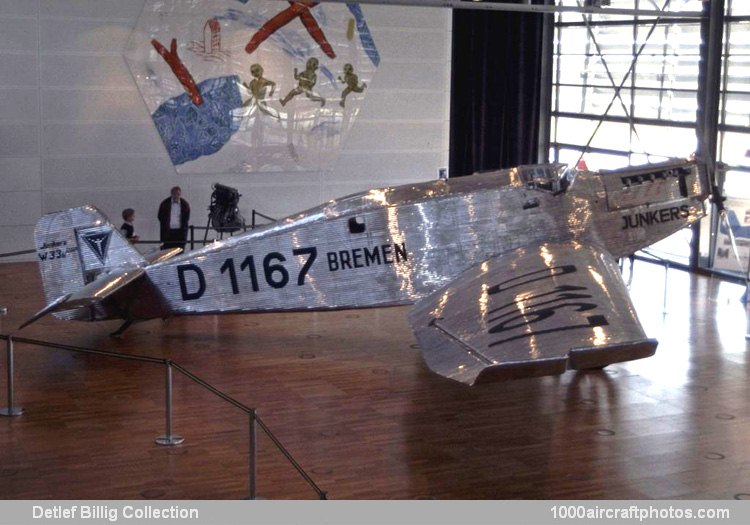Adapted from a F 13, the first prototype was named "Schildkrähe" (Hooded Crow) with the registration D-921 (c/n 794) and, unlike most of its successors, had a wooden propeller and wire-braced tail plane. During a long career this aircraft underwent many modifications and flew both as a landplane and seaplane, before spending its later years in service in Iran. D-1048 (c/n 2500), completed in 1927, was the first of 198 production aircraft to be built over a production run extending to 1934. The total number of W 33 variants approached the 30 mark, most, including the W 33b, W 33c, W 33dd and W 33f, being powered by a single 310 hp Junkers L5 engine. Junkers L5Gs of 340 hp were installed in W 33c3e and W 33he aircraft, whilst the W 33dGao had a 540 hp Siemens Sh 20 radial.
Enjoying extensive service with airlines in countries ranging from Germany to China, and Canada to New Guinea, most W 33s were operated as freighters or mail carriers, with windowless cargo compartments except for a small transparency in the doors of certain later aircraft. They inaugurated Lufthansa's first regular mail schedules, and the airline's four-strong fleet entered service in 1929. Other applications included crop spraying and aerial survey work, whilst the Luftwaffe made use of W 33he's in some numbers, as trainers.
It was a W 33 (either the Bremen D-1167 or the Europa D-1197) which, in the hands of Cornelius Edzard and Johann Risztics, established a world endurance record on August 3-5, 1927, of 52 hr 23 min. Another W 33, specially modified and piloted by Willy Neuenhofen, achieved a height of 41,800 ft (12,740 m) on May 26, 1929, creating a new world altitude record. One experimental aircraft appeared in unusual guise with two three-bladed propellers driven via right angle shafts from a single nose-mounted engine.
The pictured aircraft was built on July 28, 1927 and owned by Junkers in Dessau. Named Bremen it was one of two identical aircraft selected for the first attempt to make a non-stop east-to-west transatlantic crossing by heavier-than-air aircraft. The aircraft were fitted with extra tanks in the wing center section, the wings and in the fuselage, increasing the range from 621 to 4,785 mls (1,000 to 7,700 km). The L5 engine output was boosted by 50 hp. Crew of the Bremen were Fritz Loose, Hermann Köhl and Ehrenfried Günther Freiherr von Hünefeld. Crew of the second aircraft, the Europa D-1197, were Johann Risztics, Cornelius Edzard and an American reporter, Hugo Rengro Knickerbocker. Both aircraft took off from Dessau on August 14, 1927, and soon track of each other was lost. After engine failure the Europa crash landed in Bremen, Germany and was written off. The Bremen reached the Atlantic, but due to bad weather had to return to Dessau, landing after nearly 22 flying hours.
During the winter the Bremen was modified. The span of the wing increased by an 11.8 in (0.3 m) tilted wing tip on each side and the rudder was enlarged, while a number of instruments were replaced. Sponsored by merchants in the city of Bremen, von Hünefeld bought the aircraft from Junkers in February. As by then the authorities were against another east-west transatlantic attempt, the aircraft was secretly transferred from Berlin Tempelhof airport to Baldonnel in Ireland by Köhl, Arthur Spindler and von Hünefeld on March 26, 1928. Upon arrival in Ireland Köhl was notified that for performing the transfer flight he was sacked by his employer Deutsche Luft Hansa. Despite this Köhl decided to continue the attempt, but Spindler voluntarily withdrew. As a replacement the commander of the airport, Major James C. Fitzmaurice, joined the crew, although severe weather delayed a departure by two weeks.
On April 12, 1928 the Bremen took off from Baldonnel. It had been hoped to reach New York in the USA but strong prevailing westerly winds forced an earlier landing and after 36 hr 30 min flying the Bremen landed on a frozen lake at Greenly Island, Quebec, Canada. The first east-to-west transatlantic flight was successfully completed, however, the aircraft partly sank through the ice, damaging the propeller. Eventually the three transatlantic pioneers were rescued and on May 17 a reception was held for them in New York and two million people attended the Broadway ticker-tape parade. President Calvin Coolidge presented the three pioneers the Distinguished Flying Cross, and became the first non-Americans to receive that decoration.
Meanwhile the Bremen had been repaired and was to be flown to New York, however, shortly after take off it made a crash landing and the aircraft was then shipped to Germany. There it was exhibited in Berlin, Dresden and Bremerhaven, but no renowned museum was interested in the aircraft. Thereupon von Hünefeld decided to donate it to the American people as thanks for their hospitality. (Unfortunately von Hünefeld was not able to do this in person as he passed away on February 5, 1929, at the age of 36.) In May 1929 the Bremen was shipped to New York, handed over to the City of New York and put on display at the Grand Central Railway Station for six month. In 1930 it was transferred to the Smithsonian Institution in Washington, D.C., in 1936 it was transferred to the Henry Ford Museum in Dearborn in Detroit, Michigan.
In 1992, von Hünefeld's 100th birthday triggered the initiative "Wir holen die BREMEN nach Bremen" (We bring the BREMEN to Bremen) and in early 1997 the Henry Ford Museum signed the long-term loan contract. On April 21, 1997 the Bremen arrived in Germany aboard two Transall aircraft, subsequently it was restored by Lufthansa. In June 1998 the restoration was finished and on August 7, 1998 it was put on display the the newly erected "Bremenhalle" at Bremen Airport."
|
|
W 33 |
W 33 |
